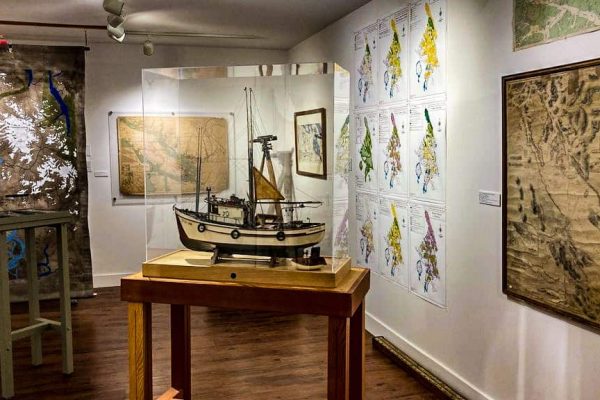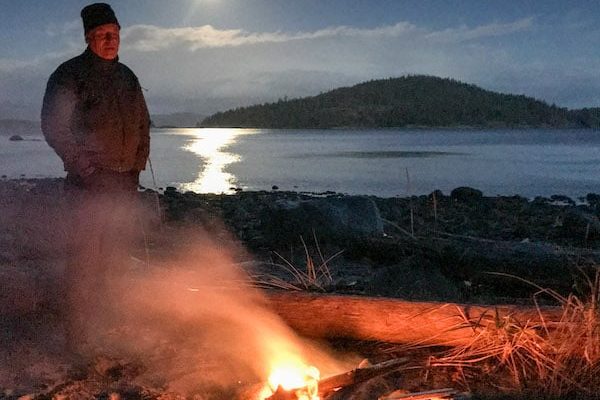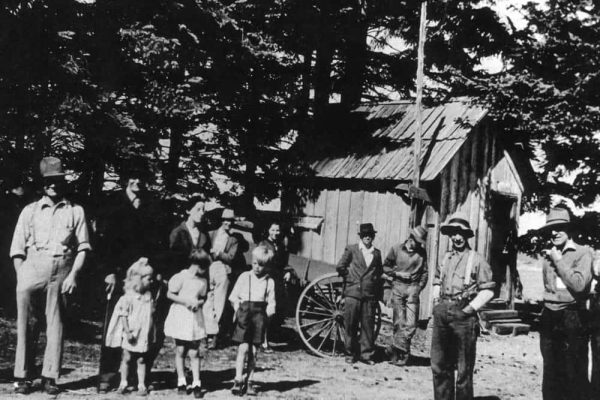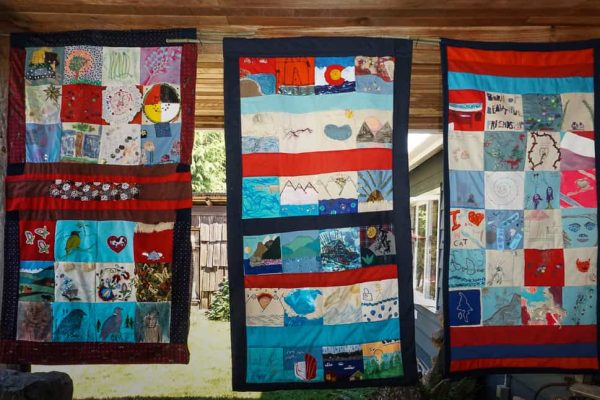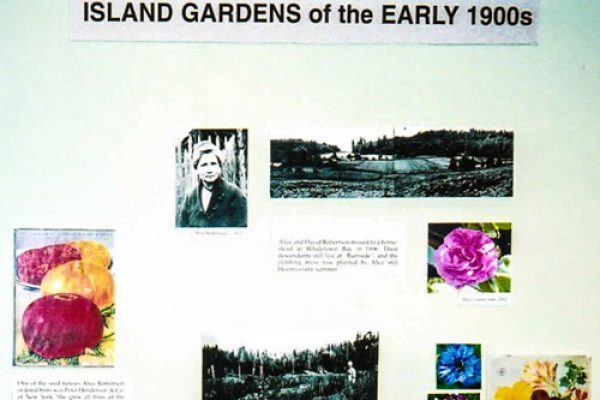2021 That Was Then / This Is Now
This exhibition is a look back at the past two decades since the Cortes Island Museum & Archives has been open to the public (1998 to now!). Follow the timeline along the wall to learn about our behind-the-scenes life at the Museum. Explore our major exhibits over the years and the biggest changes we’ve gone through as an organization. Plus learn about museum practices, collections, and curation.
The exhibit features some of the most popular artifacts that have been featured in other exhibits over the years (Sylva Jane boat model, Marswells Stove, clam cans, taxidermy).
Exhibit Timeline
1995 – May’s Dream
- May Ellingsen was the granddaughter of one of the first settlers on Cortes Island, Mike Manson (who Manson’s Landing is named after).
- May Ellingsen collected stories from the early homesteaders and had a dream to open a museum on Cortes – the Cortes Island Museum & Archives was created because of her dream.
1996 – The Museum Building (an artifact itself!)
- May and a team of volunteers got the old store that was down at Manson’s Landing and moved it up to this location, then renovated it into a building that could house the museum and archives.
1998 – Opened doors and major exhibit: Celebrating the Year of the Oceans
- We opened our doors to the public with our first major exhibit, combining stories of Cortes Island’s natural and cultural histories.
1998 – Visioning
- Pull out some of the ideas from the pockets and see if we were able to make them happen (blue is suggestion or idea; red is what the museum did in response).
- We love getting ideas! Share your ideas on the chalkboard in the imagination corner or write them down on our exhibit evaluation form.
1999 – Major exhibit: Windows on Whaletown
- Sylva Jane – one of our most popular artifacts (built by Whaletowner & cartoonist, Ken Slater).
- Doreen Thompson put together so many of our exhibits and informational binders that we named our gallery after her when she passed away in 2006.
1999 – Acquiring the Gilean Douglas Collection & Archival Management Training
- Gilean Douglas lived on Cortes and was a Canadian writer (poetry, prose; her work is available in our Museum library), she donated her collection to our Museum, making it our first “fonds” (the entire collection of documents from a person or organization).
- Many of Cortes people and organizations have donated all of their documents (receipts, photos, letters, recipes, etc.) to our archives; we have a lot of information available for artists, researchers, public servants, new residents or curious visitors about what Cortes has been like over the years.
2000 – Outdoor exhibit: The Heritage Garden
- Go see for yourself! Lots of plants and trees from homesteads on the island, come to have a picnic, help yourself to an apple in the fall!
2001 – Von Donop Exhibit and Logging Shed
- Logging has been one of the most important activities and industries on the island (for better or for worse) and many of our exhibits tell the story of logging.
- We have lots of logging related artifacts in our collection – our outdoor logging shed is full of them too!
- Not too many old growth trees left on the island; if you go for a walk in many of our forests, you can see lots of old stumps with notches carved into them by the first waves of loggers.
2003 – Major exhibit: Celebrating Wild Salmon
- Fishing has been another important activity and industry for Cortes Island, so many of our exhibits have told stories about fishing.
- Learning about the unique relationship between salmon, our forests, and our people helps us to understand how we can engage more responsibly with our ocean and forest ecosystems.
2004 – Nellie’s Guest Book & Salish Collection
- Many people on the island collect Salish artifacts (lithic objects like arrowheads or stone tools) from the beaches around Cortes Island.
- Klahoose First Nation is asking for people to return these objects (or leave them on the beach).
- Our Museum has decided not to show Klahoose or Salish objects in our exhibits until we have developed new and more appropriate ways of doing so, in partnership with Klahoose First Nation.
- Check out The Journey Home – Klahoose First Nation is on a global search for stolen ancestral remains and artifacts.
2005 – Manson’s Landing
- We have told the story of Manson’s Landing mainly from the perspective of settlers over the years, but we are learning more about Indigenous histories in this region and are changing the ways we research and tell stories.
- The ayajuthem name for Manson’s Landing is ɬaytoθɛn (tla toe then) which means “facing inward at mouth”; practice saying it!
- Check out the “Black Dress” story – very interesting to consider the different ways stories can be told in a museum, depending on the curator’s goals.
2006–2008 – Exhibits, Booklets, Panels! Oh my!
- Over the years the Museum has produced a series of informational booklets – you can buy them in our Gift Shop.
- We also produced a series of “permanent panels” which capture major aspects of our exhibits and research projects to give an overall history of the island (check it out in our workroom).
- We are working on a project to expand and digitize our permanent panel display – what information would you be interested to know about the island?
2009 – T/VIB
- Do you need any tourist info? We’re here to help! We have maps, local tips and tourism partners, and ideas about how to be the best tourist you can be!
2010 – Major exhibit: Naming & Claiming: The Creation of Bute Inlet
- Judith Williams is an artist and historian and has curated two of our most major exhibits (Bute, Refuge Cove).
- Her books are for sale in the Gift Shop, including her new one (Cougar Companions) about Bute Inlet.
2013 – Building expansion
2015 – New website & social media
2015 – Major exhibit: Squirrel Cove – A Spirit of Place and History of Forest Fires
2016 – Major exhibit & outdoor exhibit: The Big Tree
- Check out the Big Tree Cookie outside and see if you can calculate how old it is.
2017 – 2018 – Major exhibit: Refuge Cove: Moving with the Tide
2018 – Satellite exhibit: Wild Cortes
- Wild Cortes at Linnaea Farm, 1255 Seaford Road, has costumes and masks, microscopes and discovery boxes, taxidermy displays, and more. Must see!

